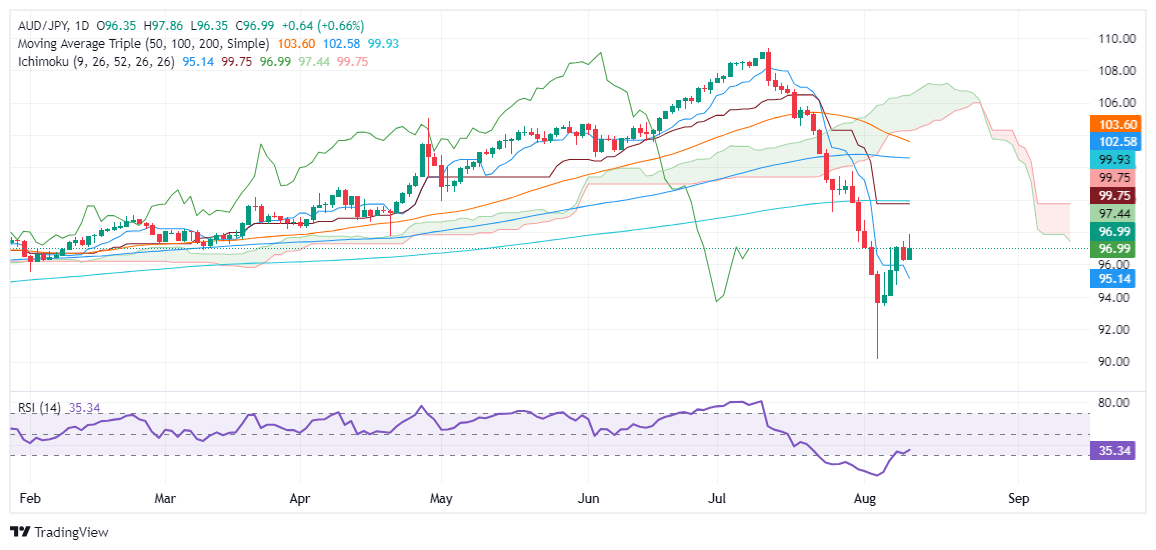- AUD/JPY is forming a ‘shooting star’ pattern, signalling the potential for further downside if the 96.15 level is broken.
- Key support levels include 96.00 and 95.00, with deeper losses targeting the Tenkan-Sen at 94.43.
- If buyers reclaim 97.85, resistance lies at 98.00, with further gains challenging 98.74.
The AUD/JPY pair is advancing on the day but is retreating after hitting a daily high of 97.85 and settling below 97.00. At the time of writing, the pair is trading at 96.97 and posting gains of 0.68%.
AUD/JPY Price Forecast: Technical Outlook
The AUD/JPY bearish trend remains in play despite the current rally that saw the Australian dollar strengthen above the 97.00 figure. Momentum is favouring sellers, although in the short term, the Relative Strength Index (RSI) is pointing below its neutral line, indicating that buyers are stepping in.
However, the price action on August 12 formed a ‘shooting star’, typically a bearish candle followed by a daily close below the low of 96.15, which could pave the way for further losses.
In that case, the first support for AUD/JPY would be the psychological mark of 96.00, before the figure of 95.00. Further losses are found below the Tenkan-Sen at 94.43.
Conversely, if AUD/JPY rises above 97.85, buyers could challenge the 98.00 mark. Further gains are seen above the confluence of the Kijun-Sen and the Senkou Span B at 98.74.
AUD/JPY Price Action – Daily Chart
Australian Dollar FAQs
One of the most important factors for the Australian Dollar (AUD) is the level of interest rates set by the Reserve Bank of Australia (RBA). Since Australia is a resource-rich country, another key factor is the price of its largest export, iron ore. The health of the Chinese economy, its largest trading partner, is a factor, as is inflation in Australia, its growth rate and the Trade Balance. Market sentiment, i.e. whether investors are betting on riskier assets (risk-on) or seeking safe havens (risk-off), is also a factor, with risk-on being positive for the AUD.
The Reserve Bank of Australia (RBA) influences the Australian Dollar (AUD) by setting the level of interest rates that Australian banks can lend to each other. This influences the level of interest rates in the economy as a whole. The RBA’s main objective is to maintain a stable inflation rate of 2%-3% by adjusting interest rates up or down. Relatively high interest rates compared to other major central banks support the AUD, and the opposite for relatively low ones. The RBA can also use quantitative easing and tightening to influence credit conditions, with the former being negative for the AUD and the latter positive for the AUD.
China is Australia’s largest trading partner, so the health of the Chinese economy greatly influences the value of the Australian Dollar (AUD). When the Chinese economy is doing well, it buys more raw materials, goods and services from Australia, which increases demand for the AUD and drives up its value. The opposite occurs when the Chinese economy is not growing as fast as expected. Therefore, positive or negative surprises in Chinese growth data often have a direct impact on the Australian Dollar.
Iron ore is Australia’s largest export, worth $118 billion per year as of 2021 data, with China being its main destination. The price of iron ore can therefore be a driver of the Australian dollar. Typically, if the price of iron ore rises, the AUD rises as well, as aggregate demand for the currency increases. The opposite occurs when the price of iron ore falls. Higher iron ore prices also tend to lead to a higher probability of a positive trade balance for Australia, which is also positive for the AUD.
The trade balance, which is the difference between what a country earns from its exports and what it pays for its imports, is another factor that can influence the value of the Australian dollar. If Australia produces highly sought-after exports, its currency will gain value solely because of the excess demand created by foreign buyers wanting to purchase its exports versus what it spends on buying imports. Therefore, a positive net trade balance strengthens the AUD, with the opposite effect if the trade balance is negative.
Source: Fx Street
I am Joshua Winder, a senior-level journalist and editor at World Stock Market. I specialize in covering news related to the stock market and economic trends. With more than 8 years of experience in this field, I have become an expert in financial reporting.








